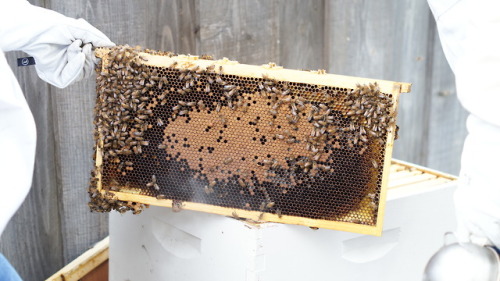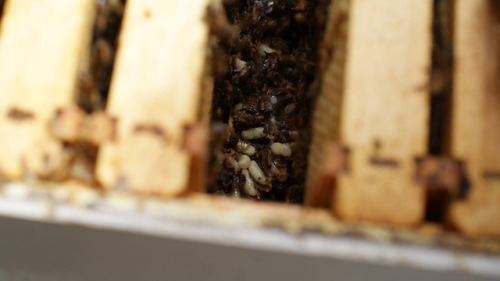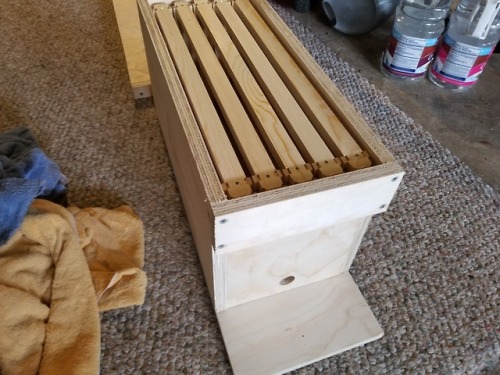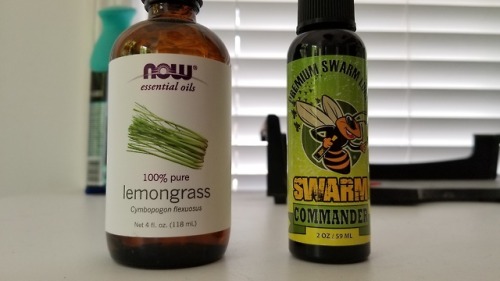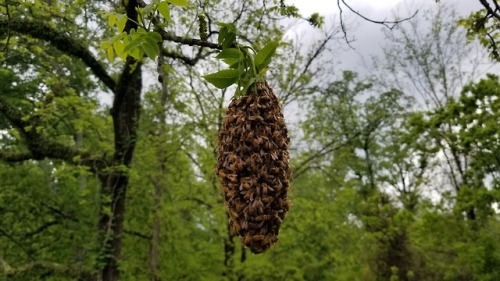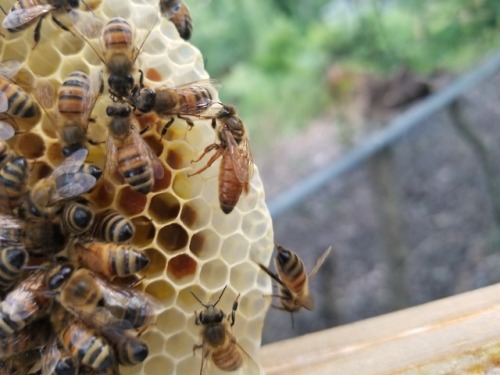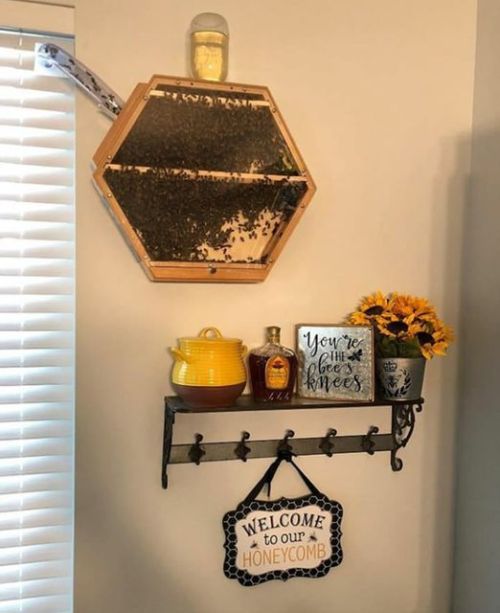#beekeeping
I forget when we found the first swarm of bees, maybe two weeks ago? Anyway, it was a small swarm and a beekeeper came over and scooped them into a hive. Then, yesterday evening, we found another much larger swarm. They were huddled in a tree near the road. A second beekeeper (brother-in-law of the first) came over right at dusk. He placed the hive under the mass of bees and then gently shook the tree. They plopped into the box, and those who were left out filed neatly and quickly inside after their queen.
At this point, who knows how many bees are still in the wall of the house. And there were three queens? Or maybe the workers made themselves a new queen very quickly after their first swarm got disrupted by cold weather. If we are REALLY lucky, maybe this is all of them, and the wall of the house is beeless, now.
Anyhoo, I very, very much wanted to walk over and gently put my hand in among the bees. I didn’t, but I wanted to.
Post link

I wanna bee… the very best…

It’s Friday!
My bees swarmed today. That means they’re doing well enough to split! Half took off and the other half will stay with me.
My dad was giving me a hard time when we did a hive check for taking so many photographs while we looked at the brood frames. Well, the other day I was out observing the hive and I came across a few feet of yard that was completely covered in dead and dying bees. The bee graveyard. You couldn’t even see the dirt of the ground, it was completely hidden by bee bodies. I collected a large drone that was scrambling around. At first glance, he looked normal, healthy. No tattered wings even. Once I scooped him up and took some photos of him, I saw it. A little brown dot, the size of a pinhead, on his fuzzy thorax. Varroa mites. AKA the bee version of ticks. They say when you see one, there’s a lot more where that came from. Then I re-examined the photos I’d taken the week before during the hive inspection. While I hadn’t noticed it the first time looking at the photos, this time I could pick out a mite here and a mite there. Then, the disfigured wings of a bee, indicating it had Deformed Wing Virus. Not good.
So now we are working on helping the bees rid themselves of the mites before the mite population grows and overwhelms the bees and we see a colony collapse. Natural treatment includes placing a mite catcher at the bottom of the hive (with a screen only the mites can fit & fall through, and sticky paper underneath to trap them) and dusting the bees themselves with a thin coat of powdered sugar which encourages them to groom themselves and then hopefully groom off the mites, dropping them down into the trap below.
I’ll post updates, but please wish our bees some extra strength and vitality as they fight off their mites! And taking photos during your hive inspections is a great way to document the hive health and provides you with clear references of your bees without having a time-limit or needing to worry about stressing them (except for that initial inspection), and then you can always go back and look for things you may have missed upon the live-inspection.
Photo descriptions:
1. A brood frame
2. A couple mites on some of the larvae
3. In the middle right you can see a drone with a mite on his thorax
4. On the far left and also in the center there are two bees with Deformed Wing Virus.
@celebrateasimplelife no, we didn’t lose them! They made a full recovery. And we did not treat them with Oxalic Acid (poison) as many keepers will recommend for mites.. we treated every few days for about a month with sprinkling them with powdered sugar which encourages them to clean themselves off and groom one another (and pull mites off). We also added a grate and sticky sheet to the bottom board so as mites fell off they would be trapped and more easily cleaned out. And finally we made sure the hive could retain its high internal temps by switching back to the “winter” top instead of the “summer” top that lets a lot more air flow through and is more cooling because the mites don’t survive in high temps (but bees do - just not too hot - but they are good at regulating and will put workers outside the entrance to fan in air if they need to)
Post link
I keep mason bees. Every day in the early spring, I go outside and watch them work. I sing to them as they store pollen from the apple trees and lay their eggs. I tell them how beautiful they are. Their children will know me next year.
How a fence made of beehives keeps crops safe from frisky elephants
Gardening in the western world involves taking measures against certain pests – such as rabbits, deer, or beetles – nibbling on crops. But we don’t have to worry about elephants merrily trampling our carefully-tended produce. But certain villages in Africa are faced with this dilemma every day. One environmentally friendly (and “elephant friendly”) solution is to install beehive fences to deter the majestic beasts from wandering inside. It turns out the old stereotype of elephants being afraid of tiny creatures is true – and it’s a profitable trick for farmers.
Post link
Every frame of Honeyland pulses with the cycles of life and glows with the film’s subject, Hatidze’s, magical vitality and optimism. This visually sumptuous, vérité glimpse into a forgotten world is an ode to two endangered and priceless treasures: human decency and the delicate balance of nature.
With honey in tow, directors Tamara Kotevska (center) and Ljubomir Stefanov (2nd from left) and the Honeyland team premiered their documentary during the 2019 Sundance Film Festival. The film took home multiple World Cinema Documentary awards including the Grand Jury Prize and two Special Jury Awards for cinematography and impact for change.
Honeyland opens in select cities on Friday, July 26.
1: Film still courtesy of Honeyland; 2: © 2019 Illya Savenok/WireImage.com
Post link






Who is this noisy little friend??? I don’t think I’ve seen this kind of bee around before! They look kind of like a squash bee mixed with a leaf cutter bee, but they burrow underground??? They’re also all in the same little clump out in the woods with none outside of maybe a 3x3m area, but each with their own little hole in the ground. If you know what this might be, feel free to tag it/reply!
Sound up for the video! They make a very cute little bz bz bz bz bz bz.
Dirt Cheap Beekeeping episode 1: What I’m gonna tell you.
First of all, beekeeping as a business or professional organization will always be “for profit” in this wonderful world of ours, so buying directly from companies that make bee equipment is generally a pretty bad deal. It will almost always be super expensive. Making your own equipment is typically much easier on the wallet. Only problem is that it will take time on your part. Then again, it’s good practice for when you are actually KEEPING the bees.
Firstly, you’ll need somewhere to out the bees once you get them. I always try to start out small swarms of bees in nucleus hives, but if you want to keep them for longer or have them make lots and lots of honey, you’ll need to have larger hives. For the nucleus hive plans I have above, you’ll need a 2x4ft piece of wood. I use plywood because it’s cheap, as about 5$ per whole hive, but it needs to be painted if you plan on keeping it outside. Plywood will fall apart and rot if not treated. To make a larger hive, simply take the dimensions of the top, bottom, front, and back, and increase their width according to how many frames you want them to fit. Each extra frame will add 1-1/16 inch to the total width. I’d advise adding 5 to start. More experienced builders may make “long langstroth” hives that have more than 10 frames in one box.
Once you have hives made, you have several options for obtaining bees. The first and most widely known method is to buy “package” bees from an established beekeeper. Now depending on both the bees and the beekeeper, this could be very expensive, so for most people it is not an option. The second option, and my personal favorite, is to locate and capture swarms! A swarm is just a big ball of bees that lands on a tree or bush or fence or really anywhere. Bees “swarm” when they grow too big for their old hive. Half of the population leaves to go find another home, and that’s why bees swarm. To capture a swarm, you can set a “baited” hive very close to them (preferably touching them) and hope they move in. You can also put a pillowcase around them and shake them in to it if you don’t want to carry around a hive. You then just pour the bees in to the desired location. Another more effective method of capturing swarms is by setting “bait hives” or “swarm traps” outside. These are just normal hives that have been “baited” with lemongrass oil or other swarm attractant such as Swarm Commander. Both of these things smell like honeybee “nasonov” pheromone, which is what bees use to tell where their home is. Though when using bait hives, you’ll need to keep a close eye on them so that once bees move in, you can get the box and move it to your bee yard to be kept before they get used to the old location. Another method to obtaining honeybees is to perform “cut-outs” on trees or houses depending on how comfortable you are doing that. It’s a lot more effort, but usually comes with more bees, pre-built comb, and lots of honey/brood.
While using any of these methods to get bees, it is always a good idea to make sure that you find the queen bee. No matter how many you miss or how much you stir up the bees, if you catch the queen, they’ll all come back exactly where you want them. You can use a queen clip that is pre-built and purchased, or you can use an old Mason jar with holes poked in the lid like I do. You just need to make sure that the queen stays out of direct sunlight and in a place where bees can easily get to. You also usually want to make sure that you capture some normal workers along with the queen, so that they can feed her and take care of her. If you caught a queen from a swarm, place her gently in the capture device in the bottom of the hive, and then set the hive as close to the rest of the bees as you can so they can smell her and move in.The rest is just keeping them normally! Once you have bees, all you need to do is take care of them and make sure they stay safe and happy~
I’ll go in to more detail on all of this in the near future. I’ll also break it down in to individual steps so that you don’t need to deal with a wall of text like this again. I’ll tag everything in this series with #DirtCheapBeekeeping #DCB and #DIY so that you can find them easily.
I’ll level with you here, I completely forgot about this. XD
If you want to get in to beekeeping but don’t want to drop 200-500$ on bee hive kits and bees, this will definitely be a great post for you! It’s a bit run-on and poorly organized, but it has lots of great info for getting started.
Go to your local library or bookstore and find a couple books on beekeeping. It may sound silly in the modern day to go *read books* but they’re honestly chock full of super useful info that you oftentimes can’t easily find online. Worth a try tbh.
As usual, my ask box here is always open for questions, comments, concerns, and whatnot as you see fit. Don’t be shy! There are absolutely no stupid questions, though I must warn you that depending on the question you may get a stupid answer.
Post link


It’s that time again!!!!
Have you ever seen bees being kept inside the house? It looks like there’s a “tunnel” for them to get in & out thru the window.
via The People Against Modern Farmhouse
I love these SO MUCH and want to build myself one at some point. Observation hives are so cool. (Though you really need to keep them in a dark room or keep a cover over them when you’re not watching them to avoid stressing them out too much.)
Post link
HOW I LOOK WITH A BEE STING TO THE EAR:

HOW I FEEL WITH A BEE STING TO THE EAR:

https://t.co/ZE571xtNkR - USA Bee colonies in serious decline! USDA: Beekeepers Lost 44% of Bee Colonies @scoopithttps://t.co/RoRYGFFniu
— mahakobees (@MahakoBees) June 5, 2016
via Twitter https://twitter.com/MahakoBees
June 06, 2016 at 08:53AM
Do you think the FLOW Hive ™ will work long term?
— mahakobees (@MahakoBees) May 31, 2016
VOTE HERE - https://t.co/Gwb0u3QlCe
via Twitter https://twitter.com/MahakoBees
May 31, 2016 at 11:07PM
Do you think the FLOW Hive ™ will work long term?
— mahakobees (@MahakoBees) May 31, 2016
via Twitter https://twitter.com/MahakoBees
May 31, 2016 at 10:56PM
https://www.youtube.com/watch?v=l2L8OLuFhmw
http://www.mahakobees.com PRACTICAL review of the #FLOW HIVE ™. This video is very different to most other videos about the Flow hive.
We take a practical approach to this review, and ask questions. Important beekeeping questions, which no doubt every #beekeeper that is interested in beekeeping also has on their mind. Will this flow hive perform as advertised? Is this new #beehive really going to revolutionize the #beekeeping industry? Is it suitable for new beekeepers and families as suggested by the Flow Hive team? Will new beekeepers have success with the flow frames and is this beehive as good as the inventors and #FlowHive manufactures claim? The quality of materials used, the honey harvest speed, the hygienic concerns during the flow hive honey harvest, Is it food grade? Will Small Hive beetles (SHB), wax moth, varroa, mites, and other pests be an issue? Will it withstand propolization and wax build up? And is the very high cost worth the investment?
Many legitimate questions that need to be answered. We recommend you take a look at the Bee Vlog beekeeping video (https://www.youtube.com/watch?v=0oPKUxsQJUc) which reviews the Flow Hive beehive with the bees well being when overwintering and points out other considerations beekeepers need to keep in mind when considering purchasing and using this beehive in their apiary. It may save your honey #bee colonies! We present no conclusions and are open minded. We hope the beekeeping community can comment below on their experience with the flow frames and that beekeepers from all corners of the world can discuss this product with their apiary location and specific beekeeping goals in mind.
We believe this to be an amazing invention that has the potential to be very beneficial once all concerns and issues raised by thousands of experienced beekeepers around the world are addressed. As with any new product, we hope this beehive continues to evolve and improve with each new version. Thank you Flow Hive ™ for thinking outside the square, and bringing the Flow frames to life. We wish you all the best and hope this product will be beneficial to all bee colonies and beekeepers alike.
If you enjoy our videos, we invite you to click the thumbs up (or down if that is how you feel), subscribe, and share our beekeeping videos. Your comments and feedback are most welcome. Happy beekeeping everyone!
Mahakobees.com
•Website http://www.mahakobees.com
•eSTORE: http://www.mahakobees.com/store.html
•Blog: http://mahakobees.com/blog
•Blog kids: http://beekeepingwithkids.blogspot.com.au/
•Youtube: https://www.youtube.com/user/mahakobees
•Google+: https://plus.google.com/+MahakoBees
•Facebook: https://www.facebook.com/mahakobees/
•Pinterest: http://www.pinterest.com/mahakobees/
•Twitter: https://twitter.com/mahakobees
•Flickr: https://www.flickr.com/photos/125372235@N04/
•Stumbleupon: http://www.pinterest.com/mahakobees/
•Tumblr site: http://mahakobees.tumblr.com/
•Tumblr blog: https://www.tumblr.com/blog/mahakobees
•LiveJournal: http://mahakobees.livejournal.com/
•Delicious https://delicious.com/mahakobees
•Diigo https://www.diigo.com/user/mahakobees
•Plurk https://www.plurk.com/
FLOW hive beehive VIDEO - a practical review beekeeping 101. To flow or not to flow. Watch now. https://t.co/yM95Vzbde2
— mahakobees (@MahakoBees) May 26, 2016
via Twitter https://twitter.com/MahakoBees
May 26, 2016 at 11:52PM
Why Nature Prefers Hexagons - Issue 35: Boundaries - Nautilus via @bdshriverhttps://t.co/AcMWU1RiYQhttp://pic.twitter.com/yzYh4Id9CN
— mahakobees (@MahakoBees) May 24, 2016
via Twitter https://twitter.com/MahakoBees
May 25, 2016 at 08:35AM
Mahako Bees (MAHAKOBEES) - Google+ https://t.co/Ng3h1iyBqa
— mahakobees (@MahakoBees) May 23, 2016
via Twitter https://twitter.com/MahakoBees
May 23, 2016 at 10:10AM
Flow Hive review Photos. Click to see them all. https://t.co/R9aWDKjBc0http://pic.twitter.com/MnbNB3dq0B
— mahakobees (@MahakoBees) May 23, 2016
via Twitter https://twitter.com/MahakoBees
May 23, 2016 at 10:14AM
No junk-food diet: Even in cities, bees find flowers and avoid processed sugars https://t.co/ffYGmoASNxvia@scoopit
— mahakobees (@MahakoBees) May 23, 2016
via Twitter https://twitter.com/MahakoBees
May 23, 2016 at 10:06AM
Flow hive beekeeping review MahakoBees https://t.co/n1PNqMfEpo
— mahakobees (@MahakoBees) May 22, 2016
via Twitter https://twitter.com/MahakoBees
May 22, 2016 at 07:18PM
popular Beekeeping videos https://t.co/fNf329cV6z
— mahakobees (@MahakoBees) May 18, 2016
via Twitter https://twitter.com/MahakoBees
May 18, 2016 at 11:38PM
DIY honey EXTRACTOR in action. Homemade honey extraction beekeeping 101 - https://t.co/2HuCbcXhMk
— mahakobees (@MahakoBees) May 18, 2016
via Twitter https://twitter.com/MahakoBees
May 18, 2016 at 06:41PM
FINALLY! It’s here! A LIMITED batch of MahakoBees PURE BEESWAX is available for purchase in our store:https://www.etsy.com/au/shop/MahakoBees.



PURE NATURAL BEESWAX
This is not your typical bulk manufactured beeswax. Our beeswax is triple filtered through a super fine mash for superior clarity, which will not splatter in candles and will provide you with a superior aromatic burn. They smell amazing! It is also food grade and smells of raw #organic#honey and pure beeswax so it is ideal for many craft projects. It comes in a range of colors, from the superior quality white bees wax, made from separated pure beeswax cappings ideal for cosmetics and lip balms, to the darker grades that deliver stronger #beeswax aromas which are perfect for candles and wax art works. Each block is an easy size to manipulate and melt for the hobbyist. Our #bees wax is NOT bleached.

Our pure #beeswax is perfect for small home craft projects, and this bulk pack provides sufficient quantity for making #candles , cosmetics, furniture polish, crafts, or weatherproofing leather products, lip balms, egg decorating, #wax painting, and so on. Our Beeswax Ingots are #handmade, hand poured and triple filtered in Queensland from #beehives in our small boutique apiary.
Take a look and support our beekeeping channel by placing an order which we can dispatch immediately. We can deliver worldwide, but if your location is not listed, please drop us a line and we will send you the shipping details.



We thank you for your support in advance!
MahakoBees
https://www.etsy.com/au/shop/MahakoBees
http://www.mahakobees.com/store.html


